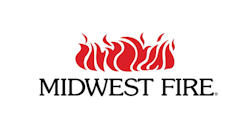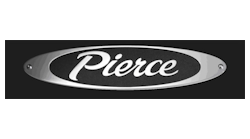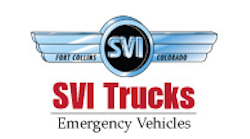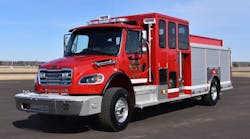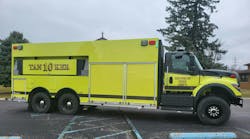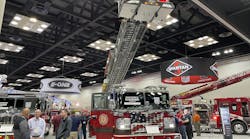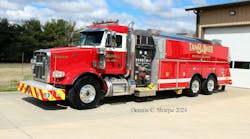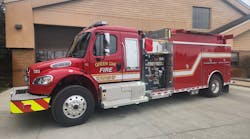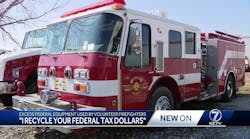Putting the wet stuff on the red stuff is a well-known firefighting adage. After all, establishing a reliable water supply is critical to a safe and successful operation, but, sometimes, this can be easier said than done.
Although it’s estimated that there are at least 10 million fire hydrants in the United States, that fact is of little consequence if there isn’t a working one anywhere near the fire.
That’s where tankers, or tenders, come in, and the category is experiencing a rather steady flow of change. An increase in water-carrying capability is included in that.
Take, for example, the Yadkinville, NC, Volunteer Fire Department’s (YVFD) purchase of a 3,000-gallon tanker a little more than two years ago. YVFD Chief Jody Doss tells Firehouse Magazine that the purchase was largely ratings driven.
“We are a city department that also covers an area with no hydrants,” Doss says. “Our former tanker had a small pump and only 1,200 gallons of water, so we needed to upgrade.”
Among the features that were specified by the YVFD’S apparatus committee were suctions and discharges on all four sides and 10-inch air-operated dump chutes on the sides and rear. The rig can be completely emptied in one minute and 15 seconds.
Tanker specifications such as YVFD don’t surprise Neal Brooks, who is the national sales manager for the apparatus division of W. S. Darley & Co. “The PolyBilt body has allowed Darley to increase the amount of water that can be safely carried on both single-axle tankers and tandem-axle tankers,” Brooks says. He explains that PolyBilt apparatus bodies aren’t susceptible to all of the weather- and electrolysis-related problems that occur that cause rusting, corrosion and pinhole leaks.
Capt. Tyler Clark of the Pine Hill Fire Department in Aberdeen, NC, says increased tank size means a lot to his agency. A current unit that has a 1,000-gallon tank (the common size for department) is being replaced. “We can now deliver twice as much water with one rig,” he says. “We are a small county, and to my knowledge this will be the largest tanker put in service.”
Tanks that are constructed out of Poly play a role, too, in availability of tankers that carry more water than their predecessors can.
Joel Konecky, who is vice president of sales for SVI Trucks, notes that the combination of Poly tanks and an increase in the amount of baffling that’s incorporated into those tanks sets the stage for a new water-carrying era for tankers.
So does never-before-seen low centers of gravity for the tanks.
Water tank design evolution also has contributed to a rethinking of tanker functionality. Rectangular water tanks are becoming more commonplace compared with the elliptical tank design of the past.
“I attribute this to the need for fire departments to carry more equipment with them on calls,” Ken Sebo, who is the pumper business development manager for Pierce Manufacturing, says. A rectangular-shaped water tank allows a larger body compartment, providing more storage space and a hosebed to carry additional equipment and more hose.”
The versatile tanker
The capability to carry more equipment contributes to a broader utilization of tankers by many departments across the country.
“With the continued decline in volunteer firefighters, the majority of our customers are designing multipurpose tankers,” Midwest Fire’s technical lead, Don Kalass, offers.
Kalass tells Firehouse Magazine typical pumper fare is being specified for tankers. This includes SCBA seating, scene lighting, deck guns, monitors and ladder storage/ladders.
The inclusion of camera systems that provide both a rearview and a bird’s-eye view maximizes tanker efficiency.
“You should always use a ground guide, but there can be situations that you have to get the job done and a ground guide is a luxury that you just don’t have,” SVI’s Konecky adds.
The same goes for in-cab controls.
“Remote control front monitors and in-cab dump valve controls” work to aid volunteer fire departments that have suffered declining membership, Kalass points out.
As A.H. Stock President Dave Stock and Larry Schetter, who is the company’s sales manager, make clear, their company’s Newton Kwik Dump Swivel Valve can flow 2,600 gpm to either side or to the rear of the apparatus. For apparatus that are designed simply for water shuttle operations, instead of relying on a single swivel, three individual valves can be incorporated to provide panoramic coverage, supporting unloading rates of as much as 3,700 gpm. This allows the rig to quickly clear the scene and refill.
Lt. Liam Kohler of the Pine Island, NY, Fire Department offered that his department’s 3,500-gallon rig, which was purchased in 2018, has tank-to-pump lines in both ends of the tank to facilitate complete utilization of capacity when operating in the department’s hilly terrain.
Pump-and-roll capability figures into the equation to address dwindling membership as well.
“Darley is currently building two single-axle tankers with pump-and-roll capability for Limestone Fire Protection District in Claremore, OK,” Darley’s Brooks states, “for support of their compressed air foam system (CAFS)-equipped wildland and structural units.”
This jibes with Darley’s involvement with fire departments in producing more smaller, single-axle tankers that integrate the CAFS onto the tanker profile.
Minimizing risk
Increased focus on safety was a universal response from all of the apparatus builders that we interviewed. During these discussions, apparatus chassis improvements were mentioned.
“Anti-lock brakes are standard,” Konecky claims, “and some chassis manufacturers offer electronic stability control and roll stability control along with modern suspension systems and radial tires that are designed to carry the rated gross vehicle weight at the maximum speed of the vehicle.”
One not to overstate, Konecky adds that, although all of these improvements are great advancements, “Technology is not a replacement for driver training and experience.”
Also in the safety realm, Pierce Manufacturing’s Sebo notes, “We have many options available through our Carcinogen Awareness and Reduction to Exposure (CARE) initiative to provide easy-to-clean interior surfaces, air filtration systems, cab decontamination systems, scene decontamination systems, dirty gear containment, storage options to move SCBAs out of the cab, and programmable vehicle cleaning and maintenance reminders.”
No shortcuts
Upgrades are being made continually to tankers, but nothing should be taken for granted. YVFD’s Doss advises those who are considering purchasing a new vehicle of whatever type, “Be sure to go to the factory for prebuild meetings and establish a working relationship with your salesperson.”

